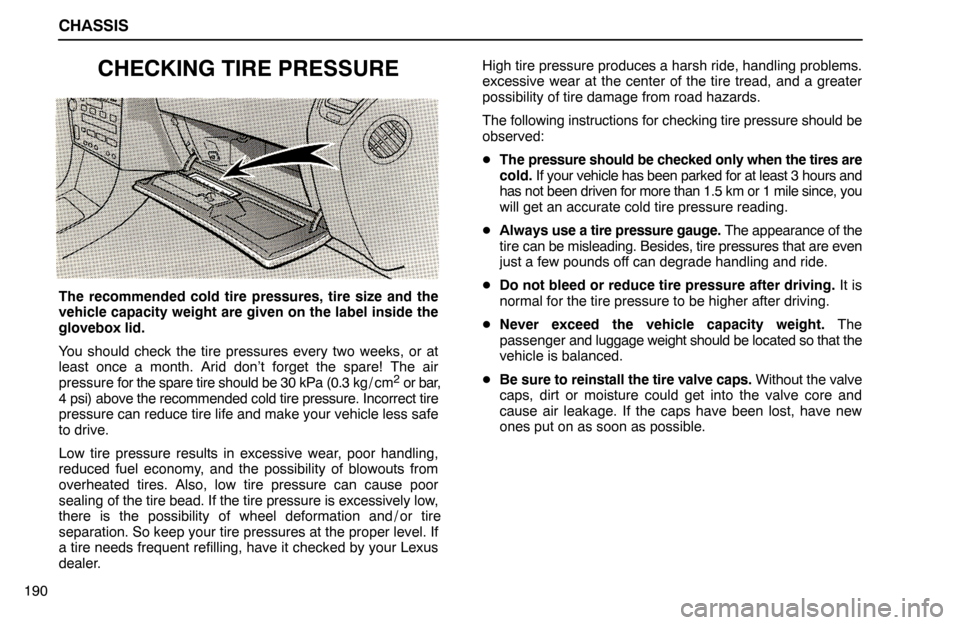Page 3 of 15
CHASSIS
183 − STEERING
Wheel freeplay
Power steering fluid type
Less than 30 mm (1.2 in.)
Automatic transmission fluid DEXRON
®-II
− TIRES AND WHEELS
Tire size
Recommended cold tire inflation pressure:
Vehicle load up to 4 occupants
Vehicle load up to vehicle capacity weight
Spare tire
Trailer towing (conventional and snow tires)
Wheel size
Standard tire
Spare tire
Wheel nut torque
P205 / 65 R15 92V or P205 / 65 R15 AS 92V
180 kPa (1.8 kg / cm
2 or bar, 26 psi) (Both front and rear)
220 kPa (2.2 kg / cm
2 or bar, 32 psi) (Both front and rear)
220 kPa (2.2 kg / cm
2 or bar, 32 psi)
220 kPa (2.2 kg / cm
2 or bar, 32 psi) (Both front and rear)
15 x 6 JJ (aluminum wheels)
15 x 6 JJ (steel wheel)
103 N
.m (10.5 kgf-m, 76 ft-lb)
Page 10 of 15

CHASSIS
190
CHECKING TIRE PRESSURE
The recommended cold tire pressures, tire size and the
vehicle capacity weight are given on the label inside the
glovebox lid.
You should check the tire pressures every two weeks, or at
least once a month. Arid don’t forget the spare! The air
pressure for the spare tire should be 30 kPa (0.3 kg / cm
2 or bar,
4 psi) above the recommended cold tire pressure. Incorrect tire
pressure can reduce tire life and make your vehicle less safe
to drive.
Low tire pressure results in excessive wear, poor handling,
reduced fuel economy, and the possibility of blowouts from
overheated tires. Also, low tire pressure can cause poor
sealing of the tire bead. If the tire pressure is excessively low,
there is the possibility of wheel deformation and / or tire
separation. So keep your tire pressures at the proper level. If
a tire needs frequent refilling, have it checked by your Lexus
dealer.High tire pressure produces a harsh ride, handling problems.
excessive wear at the center of the tire tread, and a greater
possibility of tire damage from road hazards.
The following instructions for checking tire pressure should be
observed:
�The pressure should be checked only when the tires are
cold. If your vehicle has been parked for at least 3 hours and
has not been driven for more than 1.5 km or 1 mile since, you
will get an accurate cold tire pressure reading.
�Always use a tire pressure gauge. The appearance of the
tire can be misleading. Besides, tire pressures that are even
just a few pounds off can degrade handling and ride.
�Do not bleed or reduce tire pressure after driving. It is
normal for the tire pressure to be higher after driving.
�Never exceed the vehicle capacity weight. The
passenger and luggage weight should be located so that the
vehicle is balanced.
�Be sure to reinstall the tire valve caps. Without the valve
caps, dirt or moisture could get into the valve core and
cause air leakage. If the caps have been lost, have new
ones put on as soon as possible.
Page 12 of 15

CHASSIS
192If you have tire damage such as cuts, splits or cracks deep
enough to expose the fabric, or bulges indicating internal
damage, the tire should be replaced.
If a tire often goes flat or cannot be properly repaired due to the
size or location of a cut or other damage, it should be replaced.
If you are not sure, consult with your Lexus dealer.
If an air loss occurs while driving, do not continue driving with
a deflated tire. Driving even a short distance can damage a tire
beyond repair.
Any tires which are over 6 years old must be checked by
a qualified technician even if damage is not obvious.
Tires deteriorate with age even if they have never or seldom
been used.
This also applies to the spare tire and tires stored for future
use.
Uniform tire quality grading
This information has been prepared in accordance with
regulations issued by the National Highway Traffic Safety
Administration of the U.S. Department of Transportation.
It provides the purchasers and / or prospective
purchasers of Lexus vehicles with information on uniform
tire quality grading.
Your Lexus dealer will help answer any questions you may
have as you read this information.
DOT quality grades − All passenger vehicle tires must
conform to Federal Safety Requirements in addition to
these grades. These quality grades are molded on the
sidewall.
Treadwear − The treadwear grade is a comparative rating
based on the wear rate of the tire when tested under controlled
conditions on a specified government test course. For
example, a tire graded 150 would wear one and a half (1-1 / 2)
times as well on the government course as a tire graded 100.
The relative performance of tires depends upon the actual
conditions of their use, however, and may depart significantly
from the norm due to variations in driving habits, service
practices and differences in road characteristics and climate.